|
|
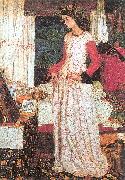 |
Morris, William
|
|
English Pre-Raphaelite Writer and Designer, 1834-1896
English designer, writer and activist. His importance as both a designer and propagandist for the arts cannot easily be overestimated, and his influence has continued to be felt throughout the 20th century. He was a committed Socialist whose aim was that, as in the Middle Ages, art should be for the people and by the people, a view expressed in several of his writings. After abandoning his training as an architect, he studied painting among members of the Pre-Raphaelites. |
|
|
|
 |
Myles Birket Foster,RWS
|
|
1825-1899
English painter, illustrator and collector. After a short and unsatisfactory period working in the family brewing business, he was able to convince his Quaker parents to allow him to pursue a career in art. He was apprenticed to a wood-engraver, Ebenezer Landells (1808-60), who recognized Foster's talent for drawing and set him to work designing blocks for engraving. Foster also provided designs for Punch and the Illustrated London News. In 1846 he set up on his own as an illustrator. The rustic vignettes of the seasons that he contributed to the Illustrated London News and its counterpart, the Illustrated London Almanack, established him as a charming interpreter of the English countryside and rural life and led to his employment illustrating similar themes in other publications. During the 1850s his designs were much in demand; he was called upon to illustrate volumes of the poetry of Longfellow, Sir Walter Scott and John Milton. |
|
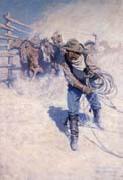 |
N.C.Wyeth
|
|
American Golden Age Illustrator, 1882-1945 |
|
|
|
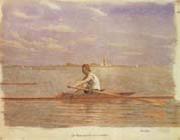 |
NC Wyeth
|
|
American Golden Age Illustrator, 1882-1945
1882-1945,was an American artist and illustrator. He was the star pupil of the artist Howard Pyle, and became one of America's greatest illustrators. During his lifetime, Wyeth created over 3,000 paintings and illustrated 112 books,25 of them for Scribner's, the work for which he is best known. Wyeth was a realist painter just as the camera and photography began to compete with his craft. Sometimes seen as melodramatic, his illustrations were designed to be understood quickly Wyeth who was both a painter and an illustrator, understood the difference, and said in 1908, |
|
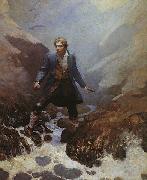 |
Newell Convers Wyeth
|
|
Newell Convers Wyeth (October 22, 1882 - October 19, 1945), known as N.C. Wyeth, was an American artist and illustrator. He was the pupil of artist Howard Pyle and became one of America's greatest illustrators. During his lifetime, Wyeth created over 3,000 paintings and illustrated 112 books, 25 of them for Scribner's, the Scribner Classics, which is the work for which he is best-known. The first of these, Treasure Island, was his masterpiece and the proceeds paid for his studio. Wyeth was a realist painter just as the camera and photography began to compete with his craft. Sometimes seen as melodramatic, his illustrations were designed to be understood quickly. Wyeth, who was both a painter and an illustrator, understood the difference, and said in 1908, "Painting and illustration cannot be mixedeone cannot merge from one into the other."
|
|
|
|
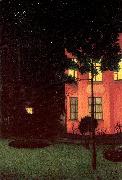 |
Nuncques, William Degouve de
|
|
Belgian Symbolist Painter, 1867-1935
was a Belgian painter. He was born at Montherme, the Ardennes, France, of an old aristocratic family, After the Franco-Prussian war (1870C71), his parents settled in Belgium, and he taught himself to paint. In 1894 he married fellow artist Juliette Massin, who introduced him to the circle of Symbolist poets, who had a considerable influence on his style. He belonged to the avant-garde group Les XX and later exhibited at La Libre Esthetique. He travelled widely and painted views of Italy, Austria and France, often of parks at night. His best-known pictures, Pink House (1892), The Angels (1894), and Peacocks (1896), demonstrate the magical quality of his work. Pink House is thought to have been a major influence on Surrealism, especially the paintings of Rene Magritte. He is supposed to have said "To make a painting, all you need to do is to take some paints, draw some lines, and fill the rest up with feelings." A regular exhibitor in Paris, he was championed by Puvis de Chavannes and Maurice Denis. From 1900 to 1902 he and his wife lived in the Balearic Islands, where he painted the rugged coastline and the orange groves. After suffering a religious crisis around 1910, he painted pictures that revealed his tormented state of mind, and during World War I, while a refugee in the Netherlands, he produced only minor works. In 1919 he was overwhelmed by the death of his wife and lost the use of one hand. In 1930 he married the woman who had helped him through the crisis. |
|
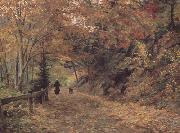 |
Olga Wisinger-Florian
|
|
Austria
born 1844 - died 1926
was an Austrian impressionist painter, mainly of landscapes and flower still lifes. She was a notable representative of Austrian Mood Impressionism. Having trained as a concert pianist, Wisinger-Florian switched to painting in the mid-1870s. She was a student of Melchior Fritsch, August Schaeffer, and Emil Jakob Schindler. From 1881 she regularly showed paintings at the annual exhibitions mounted at the artist's house and later often showed at Vienna Secession exhibitions. Work she showed at the Paris and Chicago international exhibitions earned her worldwide acclaim. The artist, who was also active in the middle-class women's movements of the time, was awarded numerous distinctions and prizes. Wisinger-Florian's early paintings can be assigned to what is known as Austrian Mood Impressionism. In her landscape paintings she adopted Schindler's sublime approach to nature. The motifs she employed, such as views of tree-lined avenues, gardens and fields, were strongly reminiscent of her teacher's work. After breaking with Schindler in 1884, however, the artist went her own way. Her conception of landscape became more realistic. |
|
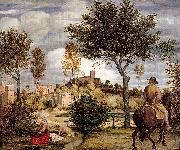 |
Olivier, Woldemar Friedrich
|
|
German, 1791-1859
.Painter and draughtsman, brother of Heinrich Olivier and Ferdinand Olivier. He first studied in Dessau under the court sculptor Friedemann Hunold (1773-1840), a pupil of Johann Gottfried Schadow, before teaching himself to paint. Following the return of his brothers from Paris, he toured the Harz with Ferdinand in 1810 and in 1811 moved with him, via Dresden, to Vienna. There he drew nudes and antiquities at the Akademie der Bildenden Kenste. In 1813-14 he participated in the uprising against Napoleonic occupation in the Letzow volunteer corps, along with his friends from Vienna, Theodor Kerner, Joseph von Eichendorff and Philipp Veit. After Kerner fell at Gadebusch (26 August 1813), Friedrich sketched him on his deathbed (Dessau, Anhalt Gemeldegal.). |
|
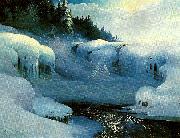 |
olof w. nilsson
|
|
1868-1956
född 12 oktober 1868 Norra Råda, Värmlands län, död 23 februari 1956, svensk konstnär, främst verksam i Karlstad, i Göteborgsregionen och i Lappland.
Nilsson deltog i det inre utsmyckandet av ett antal prestigefulla byggnader i Göteborg men gjorde sig även bekant som skicklig oljemålare med motiv hämtade såväl från Värmland och västgötabygden som från Lappland. Han är i dag främst ihågkommen som "fjällmålare". Även "isiga" landskap. |
|
|
|
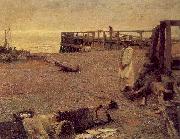 |
Osborne, Walter
|
|
Irish, 1859-1903
Irish painter. The son of the animal painter William Osborne (1823-1901), he trained in the schools of the Royal Hibernian Academy (1876-81). In 1881 he won the Royal Dublin Society's Taylor scholarship and went to study at the Koninklijk Academie voor Schone Kunsten, Antwerp. Charles Verlat was the professor of painting, and Antwerp was then at the height of its popularity with students from the British Isles. In Antwerp and subsequently in Brittany, Osborne made contact with painters of the Newlyn school and other British naturalists. In Brittany he painted Apple Gathering, Quimperle (1883; Dublin, N.G.), a small greenish-grey picture of a girl in an orchard, which in subject and treatment shows the influence of Jules Bastien-Lepage. Throughout the 1880s Osborne worked in England, joining groups of artists in their search for the ideal naturalist motif. In the autumn of 1884 he was at North Littleton, near Evesham (Heref. & Worcs), where he painted Feeding Chickens in weather so cold that his model, a young peasant girl, nearly fainted. It is carefully drawn but painted with the square-brush technique characteristic of Bastien-Lepage's followers, and is very close to the contemporary work of George Clausen and Edward Stott (1855-1918). At Walberswick in Suffolk he painted October Morning (1885; London, Guildhall A.G.), a carefully studied plein-air work using bright dots of pure colour on a base of beige and grey. During this time Osborne gave careful attention to the showing of his work. He exhibited regularly at the Royal Hibernian Academy in Dublin from 1877 and at the Royal Academy in London from 1886. |
|
|
|
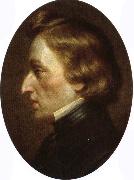 |
oscar wilde
|
|
Born: 16 October 1854
Birthplace: Dublin, Ireland
Died: 30 November 1900
Best Known As: The author of The Importance of Being Earnest
|
|
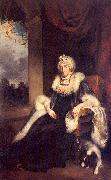 |
Owen, William
|
|
English, 1769-1825
English painter. The son of a bookseller, he was educated at the grammar school in Ludlow and was sent to London in 1786 to study under Charles Catton the elder (1728-98), coach painter to George III and founder-member of the Royal Academy. Owen's copy of a work by Reynolds, made soon after his arrival, attracted the latter's attention. He entered the Royal Academy Schools in 1791 and exhibited at the Royal Academy the following year. From then on he exhibited there every year, apart from 1823 and 1825, and was elected ARA in 1804 and RA in 1806. He painted a number of rural scenes but specialized in portrait painting. Although his reputation was eclipsed by that of Thomas Lawrence, he was sought after by many of the eminent figures of the day, producing portraits of the Archbishop of Canterbury, Dr William Howley (1813), and of the politician and essayist John Wilson Croker (exh. 1812; both London, N.P.G.); other of his sitters were William Pitt the younger and John Soane. In 1810 he was appointed portrait painter to the Prince of Wales (later George IV) and in 1813 principal portrait painter to the Prince when the latter became Prince Regent. The Prince Regent does not seem to have sat to him but nonetheless he offered Owen a knighthood, which the painter refused. From c. 1820 Owen's health deteriorated until a disease of the spine confined him to his room and finally rendered him incapable of painting. He died after accidentally taking a bottle of opium that had been wrongly labelled. |
|
|
|
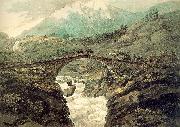 |
Pars, William
|
|
English, 1742-82
English painter. He first established himself in London as a portrait painter, exhibiting at the Society of Artists in 1760 and at the Free Society of Artists from 1761. In 1764 he won the third premium of the Royal Society of Arts for his history painting depicting Caractacus before the Emperor Claudius (untraced). In the same year he was selected by the Dilettanti Society to accompany Richard Chandler and Nicholas Revett on an archaeological expedition to Asia Minor and Greece (1764-6). His views of Classical monuments in Asia Minor were engraved and published in Ionian Antiquities (1769), while those he made in Greece, which included pioneering drawings of the Parthenon sculptures, were used in the second volume of James Stuart's Antiquities of Athens (1777). |
|
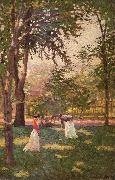 |
Paxton, William McGregor
|
|
American Painter, 1869-1941
was an American Impressionist painter. Born in Baltimore, the Paxton family came to Newton Corner in the mid-1870s, where William's father James established himself as a caterer. At 18, William won a scholarship to attend the Cowles Art School, where he began his art studies with Dennis Miller Bunker. Later he studied with Jean-L??on G??rôme in Paris and, on his return to Boston, with Joseph DeCamp at Cowles. There he met his future wife Elizabeth Okie, who also was studying with DeCamp. After their marriage, William and Elizabeth lived with his parents at 43 Elmwood Street, and later bought a house at 19 Montvale Road in Newton Centre. Paxton, who is best known as a portrait painter, taught at the Museum School from 1906 to 1913. Along with other well known artists of the era, including Edmund Charles Tarbell and Frank Benson, he is identified with the Boston School. Like many of his Boston colleagues, Paxton found inspiration in the work of the seventeenth-century Dutch painter Johannes Vermeer. Paxton was fascinated not only with Vermeer's imagery, but also with the system of optics he employed. He studied Vermeer's works closely, and discovered that only one area in his compositions was entirely in focus, while the rest were somewhat blurred. Paxton ascribed this peculiarity to "binocular vision," crediting Vermeer with recording the slightly different point of view of each individual eye that combine in human sight. He began to employ this system in his own work, including The New Necklace, where only the gold beads are sharply defined while the rest of the objects in the composition have softer, blurrier edges. |
|
 |
Pedro Weingartner
|
|
(Porto Alegre, 1853 - 1929) was an important Academic painter of Brazil, and the first artist born in Rio Grande do Sul to win international praise for his work.
Born to a family of German immigrants, he began his artistic career as an amateur, helped by his brother Inecio, who was a lithographer, and possibly also by painter Delfim da Câmara. Anyway, in 1878 he moved to Germany in order to study in the Grossherrzoglisch Badische Kunstschule, in Karlsruhe. There he became a pupil of Ferdinand Keller, Theodor Poeckh and Ernst Hildebrand. In 1880 Keller moved to Berlin, being followed by Weingärtner, who then enrolled in the local Academy.
In 1882 he left Germany for France, studying in the Academie Julian under Tony Robert-Fleury and William Adolphe Bouguereau. Wrecked by financial issues, he thought of abandoning his studies, but such situation was reverted by supportive friends, including Baron of Itajube, who got for him a special scholarship from emperor Peter II upon Bouguereau's advice. Then he could further his education in Rome.
Thereafter for many years he divided his time between Rio de Janeiro, Porto Alegre and Rome, traveling very often and being celebrated as one of the most important Brazilian painters of his generation. In Rio Grande do Sul he was a star. In 1920 he was back in Porto Alegre, where the remained until death. His fame declined from 1925 on, facing competition from new painters and changing tastes in local art. |
|
 |
Pedro Weingatner
|
|
Pedro Weingärtner (Porto Alegre, 1853 e 1929) was an important Academic painter of Brazil, and the first artist born in Rio Grande do Sul to win international praise for his work.
Born to a family of German immigrants, he began his artistic career as an amateur, helped by his brother Ineio, who was a lithographer, and possibly also by painter Delfim da Câmara. Anyway, in 1878 he moved to Germany in order to study in the Grossherrzoglisch Badische Kunstschule, in Karlsruhe. There he became a pupil of Ferdinand Keller, Theodor Poeckh and Ernst Hildebrand. In 1880 Keller moved to Berlin, being followed by Weingärtner, who then enrolled in the local Academy.
In 1882 he left Germany for France, studying in the Academie Julian under Tony Robert-Fleury and William Adolphe Bouguereau. Wrecked by financial issues, he thought of abandoning his studies, but such situation was reverted by supportive friends, including Baron of Itajube, who got for him a special scholarship from emperor Peter II upon Bouguereau's advice. Then he could further his education in Rome.
Thereafter for many years he divided his time between Rio de Janeiro, Porto Alegre and Rome, traveling very often and being celebrated as one of the most important Brazilian painters of his generation. In Rio Grande do Sul he was a star. In 1920 he was back in Porto Alegre, where the remained until death. His fame declined from 1925 on, facing competition from new painters and changing tastes in local art.
He devoted all his efforts to a half-Realist half-Romantic approach to Academicism even while such styles were already being severely challenged by Modern tendencies. Major themes in his work were mythological scenes, landscapes and genre paintings focusing mainly immigrants and the gaucho, the folk type of Rio Grande do Sul people.
|
|
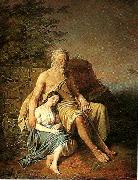 |
per wickenberg
|
|
1812-1846
Per Gabriel Wickenberg, född 1 oktober 1812 i Malmö, död 19 december 1846 i Pau, var en svensk konstnär.
Per Wickenberg kom från enkla förhållanden, hans far var fanjunkare, men visade tidigt en talang för teckning och måleri. 1831 skedde en insamling till hans förmån i Malmö, mend vars hjälp han fick möjlighet att komma till Stockholm att studera konst. Han besvärades tidigt av en ögonsjukdom, och med hjälp av bidrag från Konstföreningen i Stockholm fick han 1836 hjälp att resa till Tyskland för att söka bot. Efter tillfrisknandet valde han att stanna en tid i Berlin och vann där ett gott erkännande för sina tavlor. 1838 reste han till Paris, och vann där samma år guldmedalj på salongen för sin tavla "Nordiskt vinterlandskap". Wickenberg blev 1839 agre och 1842 ledamot av Konstakademien, under det att han stannade kvar i Paris. Wickenbergs ögonsjukdom återkom dock, och han insjuknade även i tuberkulos. Vintern 1843-44 uppehöll han sig i Nice, för att kurera sig, men förgåves, och 1846 avled han, bara 34 år gammal.
1842 tilldelades han Vasaorden och Hederslegionens kors. |
|
|
|
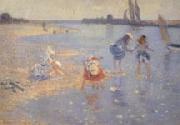 |
Philip Wilson Steer
|
|
English Painter, 1860-1942
was an English artist. Philip Wilson Steer was born in Birkenhead, the son of the portrait painter Philip Steer (1810-1871). After finding the examinations of the Civil Service too demanding, he became an artist in 1878. He studied at the Gloucester School of Art and then from 1880 to 1881 at the South Kensington Drawing Schools. He was rejected by the Royal Academy of Art and so studied in Paris between 1882 and 1884. He studied at the Acad??mie Julian, and then in the École des Beaux Arts under Cabanel. There he became one of the few English Impressionists. He is known for his landscapes, such as 'The Beach at Walberswick' (1890; Tate Gallery, London). He became a leader (with Walter Sickert) of the English Impressionist movement and was one of the founders of the New English Art Club in 1886. During the First World War, he was recruited by Lord Beaverbrook, the Minister of Information, to paint pictures of the Royal Navy. |
|
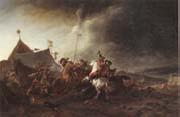 |
Philips Wouwerman
|
|
Dutch Baroque Era Painter, 1619-1668
Dutch painter and draughtsman. He was the eldest son of the painter Paulus [Pauwels] Joostens Wouwerman of Alkmaar (d 28 Sept 1642), whose two other sons, Pieter Wouwerman (1623-82) and Johannes Wouwerman (1629-66), also became painters. Philips probably received his first painting lessons from his father, none of whose work has been identified. According to Cornelis de Bie, Wouwerman was next apprenticed to Frans Hals, although no trace of Hals's influence is discernible in Wouwerman's work. Wouwerman is also reputed to have spent several weeks in 1638 or 1639 working in Hamburg in the studio of the German history painter Evert Decker (d 1647). While in Hamburg, he married Annetje Pietersz. van Broeckhof. On 4 September 1640 Wouwerman joined the Guild of St Luke in Haarlem, in which in 1646 he held the office of vinder (agent or 'finder'). Given the many southern elements in his landscapes, it has repeatedly been suggested that Wouwerman must have travelled to France or Italy, but there is no documentary evidence that he left his native Haarlem for more than short periods. |
|
 |
Picknell, William Lamb
|
|
American, 1853-1897
was a United States painter of landscapes, coastal views, and figure genres, known for his rapid painting style. He was born in Hinesburg, Vermont and died in Marblehead, |
|
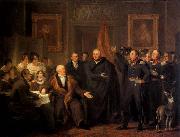 |
PIENEMAN, Jan Willem.
|
|
b. 1779, Abcoude, d. 1853, Amsterdam,Painter, teacher, engraver and museum director. He trained with a wallpaper painter in Amsterdam, and at the same time he followed courses at the Amsterdam Stadstekenacademie, where he soon distinguished himself. His artistic and didactic gifts were recognized by the Napoleonic government, which in 1805 appointed him professor of drawing at the artillery and engineering school in Amersfoort. In 1816 he was appointed assistant director of the Mauritshuis at The Hague by William I. He frequently spent time at the Dutch court, where he gave painting lessons to Queen Wilhelmina and painted many portraits of members of the royal family. He also produced a few engravings. |
|
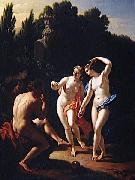 |
Pieter van der Werff
|
|
(1665 - September 26, 1722) was a Dutch Golden Age painter. He assisted his older brother, Adriaen van der Werff.
He learned to paint from his brother Adriaen and according to the RKD, he spent most of his life working in Rotterdam, where he painted the rich and famous |
|
|
|
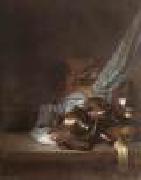 |
POORTER, Willem de
|
|
Dutch Baroque Era Painter, 1608-ca.1648
Dutch painter. His father, Pieter, came from Flanders to Haarlem, where in 1631 works by Willem were recorded for the first time. In 1634 Willem was registered in Haarlem as a master painter, and in 1635 Pieter Casteleijn was named as his pupil. As late as 1643 Pieter Abrams Poorter and Claes Coenraets began their studies with him in Haarlem. Willem is mentioned for the last time in the archives of the Haarlem Guild of St Luke in 1645, the year he left for Wijk bij Heusden. He supposedly studied under Rembrandt, together with his fellow townsman Jacob de Wet. There is no documentation to support this assumption, but a number of de Poorter's small-scale biblical and history paintings bear such a striking likeness to Rembrandt's biblical compositions of c. 1630 that the two hands are often confused. Rembrandt's Presentation in the Temple (1631; The Hague, Mauritshuis; see REMBRANDT VAN RIJN) was copied (Dresden, Gemeldegal. Alte Meister) by de Poorter, who also painted his own version (Kassel, Schloss Wilhelmsh?he). The lighting in de Poorter's Entombment (Guernsey, D. Cevat priv..) was also apparently inspired by Rembrandt's example. Since de Poorter's paintings were first reported in Haarlem in 1631, the year that Rembrandt moved from Leiden to Amsterdam, it seems likely that de Poorter received his training in the Leiden workshop, where Gerrit Dou had also been working since 1628. |
|
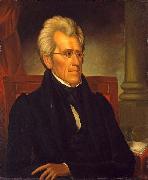 |
Ralph Eleaser Whiteside Earl
|
|
(1785-8 - Nashville, Tennessee, September 16, 1838), also known as Ralph E. W. Earl or Ralph Eleazer Whiteside Earl, was an American painter known as the "court painter" to President Andrew Jackson.
Earl was the son of portrait painter Ralph Earl and his second wife Ann Whiteside. He was born c. 1785-88, probably in New York City, and likely received his early training in portraiture from his father, whose naive style is reflected in the younger Earl's earliest works. He traveled to London in 1809, where he studied for a year with John Trumbull and was advised by Benjamin West, learning perspective, anatomy, and three-dimensional illusion. He remained in England until 1814, living with his maternal grandfather and uncle in Norwich and executing portrait commissions. He then traveled to Paris before returning to the United States in December 1815 with the intention of creating grand-scale history paintings on the European model.
As preparation for a planned project depicting the Battle of New Orleans, Earl met General Andrew Jackson and visited him at his Tennessee home, The Hermitage, in January 1817. Earl painted portraits of Jackson and his family, and married Mrs. Jackson's niece Jane Caffery on 19 May 1819. She died in childbirth in 1820. |
|
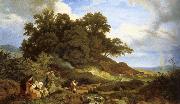 |
ralph vaughan willams
|
|
Period: Romantic (1820-1869)
Country: Germany
Born: February 03, 1809 in Hamburg, Germany
Died: November 04, 1847 in Leipzig, Germany |
|
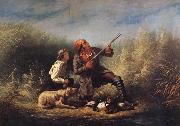 |
Ranney William Tylee
|
|
German-born American Painter, 1813-1857
American painter. He spent six formative years in the hill country of North Carolina. By 1834 he was working and studying drawing in New York, but two years later he went to Texas to join in the war for independence. Although he returned to New York a year later, it was not until 1846, with the outbreak of the Mexican War, that Ranney began to use his Western experience as the basis for his painting. With the encouragement of the American Art Union, he executed three types of Western subject: the Western trapper or hunter, pursuing a dangerous life on the prairies, as in Trapper's Last Shot (1850; untraced; engraved and lithographed by T. Dwight Booth); the pioneer family, heading across the plains with children, dogs and goods, as in Advice on the Prairie (1853; Malvern, PA, Claude J. Ranney priv. col.); and the dangers of emigration, for example Prairie Fire. |
|
|
|
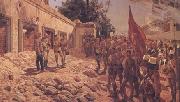 |
Richard Caton Woodville
|
|
1856 - 1927
was an English artist and illustrator, who is best known for being one of the most prolific and effective painters of battle scenes in the late nineteenth, and early twentieth centuries. The son of American Richard Caton Woodville (The First), who was also a talented artist, Woodville studied at the Dusseldorf School under the great Prussian military artist Wilhelm Camphausen, and then Eduard von Gebhardt, before briefly studying in Russia and then Paris under Gerome. Woodville spent most of his career working for the Illustrated London News where he quickly developed a reputation as a talented reporter and writer, but was also published in Cornhill Magazine, Strand Magazine, and The Tatler. Richard Caton Woodville first experienced battle first-hand when he was sent by the Illustrated London News to report upon the Russo-Turkish War (1877 C 1878), and then again in the 1882 Anglo-Egyptian War where he made numerous sketches, and also obtained photographs of the trenches at Tel-e-Kebir for his friend and co-artist Alphonse-Marie-Adolphe de Neuville whom had been commissioned to paint a scene of the battle. In 1879 Woodville's Before Leuthen, Dec 3rd, 1757 was exhibited in the Royal Academy. It proved popular, and afterwards he began to regularly be exhibited in Burlington House, where 21 of his battle paintings were eventually shown. His most popular works there were ones that dealt with contemporary wars, such as the Second Anglo-Afghan War, Candahar [sic], and Maiwand, Saving the Guns (Walker Art Gallery), the Zulu War, and the First Boer War. His works from Egypt were exhibited at the Fine Art Society in 1883, where his painting The Moonlight Charge at Kassassin proved very popular. The following year he exhibited by Royal Command another painting he had done of the war in Egypt, entitled The Guards at Tel-e-Kebir (Royal Collection). He continued to paint scenes of battle, and few battles or wars that Great Britain fought during his life were not touched upon by him, including the Second Boer War, and World War I. Despite his precocious talent for capturing the dramatic moments of contemporary battles, Woodville also enjoyed recreating historical scenes in both oil, and watercolour. The Illustrated London News commissioned him to complete a commemorative special series recreating the most famous British Battles of history. He depicted The Charge of the Light Brigade (Royal Collection, Madrid) and The Charge of the 21st Lancers at Omdurman (Walker Art Gallery), Battle of Blenheim, Battle of Badajos and several Battle of Waterloo pictures. During World War I, Woodville was compelled to return to the depiction of current events, and three of his Great War works were displayed in the Royal Academy. |
|
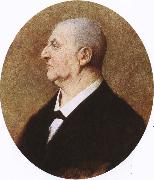 |
richard wagner
|
|
Born: 22 May 1813
Birthplace: Leipzig, Germany
Died: 13 February 1883
Best Known As: German composer of Der Ring des Nibelungen |
|
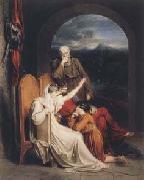 |
Richard Westall
|
|
English Painter, 1765-1836
was an English painter. Westall was the more successful of two half-brothers (both sons of a Benjamin Westall, from Norwich), who each became painters. His younger half-brother was William Westall (1781C1850), a much-travelled landscape painter. Born on 2 January 1765 in Reepham near Norwich (where he was baptised at All Saints on 13 January in the same year) Richard Westall moved to London after the death of his mother and the bankruptcy of his father in 1772. He was apprenticed to a heraldic silver engraver in 1779 before studying at the Royal Academy School of Art from 10 December 1785. He exhibited at the Academy regularly between 1784 and 1836, became an Associate in November 1792 and was elected an Academician on 10 February 1794. From 1790 to 1795 he shared a house with Thomas Lawrence (later Sir), the future Royal Academy president, at 57 Greek Street, on the corner of Soho Square, each of the artists placing their name on one of the entrances. His works C many in water-colour - caused great interest in the late years of the 18th century when he was considered by his chief patron Richard Payne Knight as an outstanding artist of the picturesque. He painted works in a neo-classical style for John Boydell's Shakespeare Gallery and for Henry Fuseli's Milton Gallery. His painting of John Milton and his daughters hangs in Sir John Soane's Museum in London. A number of scenes in which Westall depicts events in the life of Horatio Nelson are at the Maritime Museum. Westall was a prolific illustrator of books of poets and writers including Sir Walter Scott and Oliver Goldsmith, Byron - who greatly admired his work, stating that "the brush has beat the poetry". He also illustrated editions of the Bible, |
|
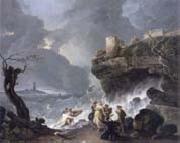 |
Richard Wilson
|
|
Welsh Romantic Painter, ca.1713-1782
was a Welsh landscape painter, and one of the founder members of the Royal Academy in 1768. Wilson has been described as '...the most distinguished painter Wales has ever produced and the first to appreciate the aesthetic possibilities of his country.' Wilson is considered to be the father of landscape painting in Britain. The son of a clergyman, Wilson was born in Penegoes, Montgomeryshire. The family was an old and respected one, and Wilson was first cousin to Charles Pratt, 1st Earl Camden. In 1729 he went to London where he began as a portrait painter, under the apprentership of an obscure artist, Thomas Wright. From 1750 to 1757 he was in Italy and adopted landscape on the advice of Francesco Zuccarelli. Painting in Italy and afterwards in England, he was the first major British painter to primarily concentrate on landscape. He composed well, but saw and rendered only the general effects of nature thereby creating a personal, ideal style influenced by Claude Lorrain and the Dutch landscape tradition. According to John Ruskin, he "paints in a manly way, and occasionally reaches exquisite tones of colour." He concentrated on painting Italianate landscapes and landscapes based upon classsical literature, but when his painting The Destruction of the Children of Niobe (c.1759-60) won high acclaim he gained many commissions from wealthy families seeking classical potrayals of their estates. |
|
|
|
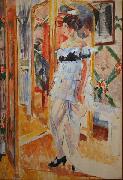 |
Rik Wouters
|
|
(21 August 1882, Mechelene11 July 1916, Amsterdam) was a Belgian fauvist painter and sculptor. Wouters was educated at the Academie Royale des Beaux-Arts in Brussels.
|
|
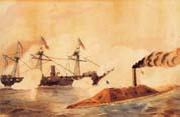 |
Robert W. Weir
|
|
American Hudson River School Painter, 1803-1889,Painter and teacher. By his own account he was self-taught, with the exception of a few lessons from an unknown heraldic painter named Robert Cooke. However, after exhibiting a few works that were praised by the local press, he was sent to Italy by a group of New York and Philadelphia businessmen for further studies. There he trained with Florentine history painter Pietro Benvenuti. After three years in Europe (1824-7), he returned to New York, where he quickly became a mainstay of the artistic community. In 1831 he was elected to membership in the National Academy of Design in New York, and three years later he was made instructor of drawing at the US Military Academy in West Point, New York, a post he held for the next 42 years. Most scholars agree that he was more important as a teacher than as a painter. His best known work is the Embarkation of the Pilgrims (1837-43), which hangs in the Rotunda of the US Capitol Building in Washington, DC. |
|
|
|
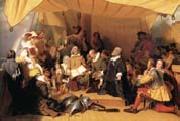 |
Robert Walter Weir
|
|
Jun 18.1803-May 1.1889, Painter and teacher. By his own account he was self-taught, with the exception of a few lessons from an unknown heraldic painter named Robert Cooke. However, after exhibiting a few works that were praised by the local press, he was sent to Italy by a group of New York and Philadelphia businessmen for further studies. There he trained with Florentine history painter Pietro Benvenuti. After three years in Europe (1824-7), he returned to New York, where he quickly became a mainstay of the artistic community. In 1831 he was elected to membership in the National Academy of Design in New York, and three years later he was made instructor of drawing at the US Military Academy in West Point, New York, a post he held for the next 42 years. |
|
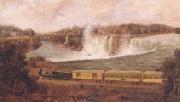 |
Robert Whale
|
|
Born in Alternun, England in 1805. Died in Brantford, Ontario in 1887 |
|
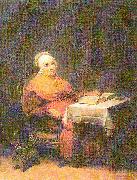 |
Robert Wilhelm Ekman
|
|
(August 13, 1808 - February 19, 1873), aka R. W. Ekman, was a significant teacher and painter of the Finnish romantic portraits and early national romanticism.
Robert Ekman was born in Uusikaupunki, Finland to an upper class family. His father was Karl Kristoffer Ekman, a medical doctor and a mayor. Mother was Sara Elisabet (maiden name Gadolin). Robert Ekman's both parents died when he was about 10 years old. They left behind five orphans who were placed in foster homes. Schooling was incomplete and there was no chance of academic education.
Robert Ekman first studied in Finland under the guidance of Gustaf Wilhelm Finnberg, but in 1824, with his brother Fredrubjm begun studies in Kungliga Akademien för de Fria Konsterna (The royal academy for free arts) in Stockholm. Already as a student Ekman specialized in portraying the life of the common people, instead of Classicism of the academic arts. Ekman graduated in 1836, and was granted a generous traveling scholarship for excelling in his studies. That supported him working in Holland, France and Italy between years 1837-1844. As the scholarship was not plausible otherwise, Ekman took the Swedish citizenship.
|
|
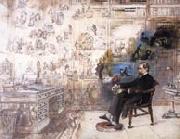 |
Robert William Buss
|
|
British painter and etcher , 1804-1875
was a Victorian artist, etcher and illustrator perhaps best known for his painting Dickens' Dream. Born in Bull and Mouth Street, Aldersgate in London in 1804, Buss served an apprenticeship with his father, a master engraver and enameller, and then studied painting under George Clint, a miniaturist, watercolour and portrait painter, and mezzotint engraver. At the start of his career Buss specialized in painting theatrical portraits, with many of the leading actors of the day sitting to him, including William Charles Macready, John Pritt Harley, and John Baldwin Buckstone. Later Buss painted historical and humorous subjects. He exhibited a total of 112 pictures between 1826 and 1859, twenty-five at the Royal Academy, twenty at the British Institution, |
|
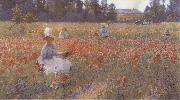 |
Robert William Vonnoh
|
|
American portrait and landscape painter, 1858-1933
was an American Impressionist painter known for his portraits and landscapes. |
|
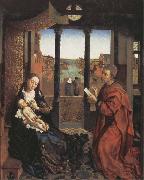 |
Roger Van Der Weyden
|
|
c.1399-1464
Rogier van der Weyden was the son of Henri de le Pasture, a cutler in Tournai, and Agn?s de Watreloz. His birthdate is estimated from the facts that he was stated to be 35 in April 1435 and 43 in September 1441. Before or in 1427 he married Elisabeth Goffaert (c. 1405-77), whose father was a prosperous shoemaker in Brussels. Rogier may have lived for a time in Brussels: his eldest child Cornelis (b 1427) was sometimes referred to as 'de Bruxella' but was not necessarily a native of Brussels. On 5 March 1427 'Rogelet de le Pasture, natif de Tournai' was apprenticed to the Tournai painter Robert Campin. This Rogelet duly completed his apprenticeship in 1431 and on 1 August 1432 became a master of the Tournai guild. Despite much debate, it would appear that Rogelet was Rogier van der Weyden, though it has also been argued that in 1427 Rogier was a married man well past the normal age of apprenticeship and that Rogelet must have been a second Tournai painter of the same name. JACQUES DARET, however, was in his twenties when in 1428 he was apprenticed to Campin, and other instances can be cited of married apprentices. The political situation at Tournai in 1427-8 was unusual, and the guild system was not functioning normally. |
|
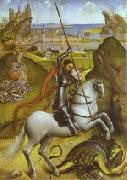 |
Rogier van der Weyden
|
|
Rogier van der Weyden 1399/1400 - 1464 was the most important representative of Netherlandish painting or Northern Renaissance ... is, with Jan van Eyck, considered one of the greatest exponents of the school of Early Netherlandish painting. Rogier van der Weyden was born in Tournai as 'Rogier de le Pasture' (Roger of the Pasture) in 1399 or 1400. His parents were Henri de le Pasture and Agnes de Watr??los. The family had settled before in the city of Tournai where Rogiers father worked as a 'maître-coutelier' (knife manufacturer). In 1426 Rogier married Elisabeth, the daughter of the Brussels shoemaker Jan Goffaert and his wife Cathelyne van Stockem. Rogier and Elisabeth had four children: Cornelius, who became a Carthusian monk, was born in 1427, a daughter Margaretha in 1432. Before 21 October 1435 the family settled in Brussels where the two younger children were born: Pieter in 1437 and Jan the next year. From the second of March 1436 onwards held the title of 'painter to the town of Brussels' (stadsschilder) a very prestigious post because Brussels was at that time the most important residence of the splendid court of the Dukes of Burgundy. It was at the occasion of his move to the Dutch-speaking town of Brussels that Rogier began using the Dutch version of his name: 'Rogier van der Weyden'Little is known about Rogier's training as a painter. The archival sources from Tournai (completely destroyed during World War II, but luckily partly transcribed in the 19th and early 20th century) are somewhat confusing and have led to different interpretations by scholars. From a document it is known that the city council of Tournai offered wine in honour of a certain 'Maistre Rogier de le Pasture' on March the 17th 1427. However, on the 5th of March of the following year the records of the painters' guild show a certain 'Rogelet de le Pasture' entered the workshop of Robert Campin together with Jacques Daret. Only five years later, on the first of August 1432, Rogier de le Pasture obtains the title of 'Master' (Maistre) as a painter.[1] Many have doubted whether Campin's apprentice 'Rogelet' was the same as the master 'Rogier' that was offered the wine back in 1426. The fact that in 1426-1427 Rogier was a married man in his late twenties, and well over the normal age of apprenticeship has been used as an argument to consider 'Rogelet' as a younger painter with the same name. In the 1420's however the city of Tournai was in crisis and as a result the guilds were not functioning normally. The late apprenticeship of Rogier/Rogelet may have been a legal formality. Also Jacques Daret was then in his twenties and had been living and working in Campin's household for at least a decade. It is possible that Rogier obtained an academic title (Master) before he became a painter and that he was awarded the wine of honour on the occasion of his graduation. The sophisticated and 'learned' iconographical and compositional qualities of the paintings attributed to him are sometimes used as an argument in favour of this supposition. The social and intellectual status of Rogier in his later life surpassed that of a mere craftsman at that time. In general the close stylistical link between the documented works of Jacques Daret, and the paintings attributed to Robert Campin and Rogier van der Weyden is considered as the main argument to consider Rogier van der Weyden as a pupil of Robert Campin. The last mention of Rogier de la Pasture in the financial records of Tournai, on October 21, 1435, lists him as demeurrant ?? Brouxielles ('living in Brussels'). At the same time, the first mention of Rogier de Weyden is made as the official painter of Brussels. Therefore Rogier de la Pasture and Rogier Van der Weyden are thought to be one and the same painter. The post of city painter was created especially for Van der Weyden and was meant to lapse on his death. It was linked to a huge commission to paint four justice scenes for the 'Golden Chamber' of Brussels City Hall.[2] Different properties and investments are documented and witness his material prosperity. The portraits he painted of the Burgundian Dukes, their relatives and courtiers, demonstrate a close relationship with the elite of the Netherlands. The Miraflores Altarpiece was probably commissioned by King Juan II of Castile, since Juan II donated it to the monastery of Miraflores in 1445. |
|
|

